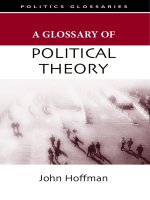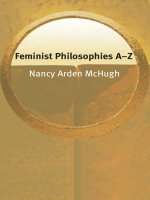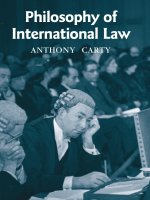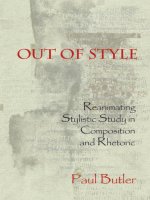edinburgh university press philosophy of language a-z mar 2007
Bạn đang xem bản rút gọn của tài liệu. Xem và tải ngay bản đầy đủ của tài liệu tại đây (994.34 KB, 201 trang )
Philosophy of Language A–Z
Alessandra Tanesini
The first glossary to cover the theories, debates, concepts, problems and
philosophers within the philosophy of language in one volume.
This essential reference tool, written in a language accessible to beginners and
non-specialists alike, provides concise and precise entries on all the relevant key
terms and issues. It includes extensive cross-references which indicate the contexts
of each entry, and can be used to deepen understanding of any given topic.
Philosophy of Language A–Z offers clear and thorough guidance on how to negotiate
the complexities of the philosophy of language.
Alessandra Tanesini is Reader in Philosophy at Cardiff University. Her publications
include Wittgenstein: A Feminist Introduction (Polity Press, 2004) and An Introduction to
Feminist Epistemologies (Blackwell, 1999).
Co
v
er design: River Design, Edinburgh
Edinburgh University Press
22 George Squar
e
,
Edinburgh EH8 9LF
www.eup.ed.ac.uk
ISBN 978 0 7486 2229 0
Alessandra Tanesini
barcode
Edinburgh
Alessandra Tanesini
PHILOSOPHY A–Z SERIES
GENERAL EDITOR: OLIVER LEAMAN
These thorough, authoritative yet concise alphabetical guides introduce the
central concepts of the various branches of philosophy. Written by established
philosophers, they cover both traditional and contemporary terminology.
Features
• Dedicated coverage of particular topics within philosophy
• Coverage of key terms and major figures
• Cross-references to related terms.
Philosophy of Language A–Z
Philosophy of Language A–Z
P1: OTE/SPH P2: OTE/SPH QC: OTE/SPH T1: OTE
EUBK026-Tanesini.cls-Sabon March 2, 2007 8:24
PHILOSOPHY OF LANGUAGE A–Z
i
P1: OTE/SPH P2: OTE/SPH QC: OTE/SPH T1: OTE
EUBK026-Tanesini.cls-Sabon March 2, 2007 8:24
Volumes available in the Philosophy A–Z Series
Christian Philosophy A–Z, Daniel J. Hill and Randal D.
Rauser
Epistemology A–Z, Martijn Blaauw and Duncan Pritchard
Ethics A–Z, Jonathan A. Jacobs
Indian Philosophy A–Z, Christopher Bartley
Jewish Philosophy A–Z, Aaron W. Hughes
Philosophy of Religion A–Z, Patrick Quinn
Philosophy of Mind A–Z, Marina Rakova
Forthcoming volumes
Aesthetics A–Z, Fran Guter
Chinese Philosophy A–Z,BoMou
Feminist Philosophy A–Z, Nancy McHugh
Islamic Philosophy A–Z, Peter Groff
Philosophy of Science A–Z, Stathis Psillos
Political Philosophy A–Z, Jon Pike
ii
P1: OTE/SPH P2: OTE/SPH QC: OTE/SPH T1: OTE
EUBK026-Tanesini.cls-Sabon March 2, 2007 8:24
Philosophy of
Language A–Z
Alessandra Tanesini
Edinburgh University Press
iii
P1: OTE/SPH P2: OTE/SPH QC: OTE/SPH T1: OTE
EUBK026-Tanesini.cls-Sabon March 2, 2007 8:24
C
Alessandra Tanesini, 2007
Edinburgh University Press Ltd
22 George Square, Edinburgh
Typeset in 10.5/13 Sabon
by TechBooks, India, and printed and
bound in Great Britain by
Antony Rowe Ltd, Chippenham, Wilts
A CIP record for this book is
available from the British Library
ISBN 978 0 7486 2228 3 (hardback)
ISBN 978 0 7486 2229 0 (paperback)
The right of Alessandra Tanesini
to be identified as author of this work
has been asserted in accordance with
the Copyright, Designs and Patents Act 1988.
Published with the support of the Edinburgh University
Scholarly Publishing Initiatives Fund.
iv
P1: OTE/SPH P2: OTE/SPH QC: OTE/SPH T1: OTE
EUBK026-Tanesini.cls-Sabon March 2, 2007 8:24
Contents
Series Editor’s Preface vii
Introduction and Acknowledgements ix
Philosophy of Language A–Z 1
Bibliography 184
v
P1: OTE/SPH P2: OTE/SPH QC: OTE/SPH T1: OTE
EUBK026-Tanesini.cls-Sabon March 2, 2007 8:24
vi
P1: OTE/SPH P2: OTE/SPH QC: OTE/SPH T1: OTE
EUBK026-Tanesini.cls-Sabon March 2, 2007 8:24
Series Editor’s Preface
Philosophy is not only expressed in language, but language is
often its main object of interest and enquiry. Not of course
language in the sense of grammar and style, which is more
the realm of linguistics and literary investigation. Language
as our medium for pursuing meaning, which in itself is the
repository of meaning, has constantly fascinated philosophers
with its ability both to enlighten and confuse. The issue of
how words mean things, an issue that seems on the face of it
so very simple, has in fact served to differentiate some of the
major philosophical schools, and continues to appear on the
battlefields of major theoretical controversies in philosophy.
One of the intriguing features of debates about language is
that they are generally conducted in terms of the very medium
under discussion.
In modern times the philosophy of language has become
rather technical in nature, and it is very helpful to have a
systematic list of explanations of many of the key concepts and
figures in the discipline. Alessandra Tanesini hasprovidedsuch
a guide, and I am sure that readers of this volume will find her
route through the thicket of different theories and arguments
a useful one to follow. A solid grasp of some of the basic
positions in the philosophy of language is indispensable for a
grasp of philosophy as a whole, and this volume is designed
to go someway to fulfilling that role.
Oliver Leaman
vii
P1: OTE/SPH P2: OTE/SPH QC: OTE/SPH T1: OTE
EUBK026-Tanesini.cls-Sabon March 2, 2007 8:24
viii
P1: OTE/SPH P2: OTE/SPH QC: OTE/SPH T1: OTE
EUBK026-Tanesini.cls-Sabon March 2, 2007 8:24
Introduction and
Acknowledgements
This dictionary introduces readers to the main theories, prob-
lems, figures and arguments in the philosophy of language.
It aims for breadth of coverage, including over 490 entries
on every topic in the philosophy of language and on many
notions in the cognate areas of logic, philosophical logic and
the philosophy of mind. Entries are written in accessible, non-
technical vocabulary and made to be as concise as possible.
Each entry is cross-referenced to others that are related to it, so
that the reader can broaden his or her knowledge of the issues
and debates connected to a given problem or figure. Further,
entries are supplemented by brief further readings.
I would like to thank Alex Miller and Michael Lynch for
suggestions about which entries to include, and Michael Dur-
rant, Richard Gray and Oliver Leaman for useful comments
on earlier drafts. Staff at Edinburgh University Press were par-
ticularly helpful with all queries and have greatly facilitated
the writing of this work.
Cardiff, Wales
May 2006
ix
P1: OTE/SPH P2: OTE/SPH QC: OTE/SPH T1: OTE
EUBK026-Tanesini.cls-Sabon March 2, 2007 8:24
x
P1: OTE/SPH P2: OTE/SPH QC: OTE/SPH T1: OTE
EUBK026-Tanesini.cls-Sabon March 2, 2007 8:38
Philosophy of Language A–Z
1
P1: OTE/SPH P2: OTE/SPH QC: OTE/SPH T1: OTE
EUBK026-Tanesini.cls-Sabon March 2, 2007 8:38
2
P1: OTE/SPH P2: OTE/SPH QC: OTE/SPH T1: OTE
EUBK026-Tanesini.cls-Sabon March 2, 2007 8:38
A
A posteriori: The term applies primarily to knowledge that is
ultimately dependent on experience or observation, and is
thus dubbed ‘empirical’. The truths of natural science are
knowable in this way. Some of these truths, such as those
about subatomic particles, might be highly theoretical.
Nevertheless, they are knowable a posteriori because they
are based on evidence which is ultimately provided by the
senses. A posteriori falsehoods are those claims whose
falsity is ultimately known by means of experience or
observation. A posteriori truths are opposed to a priori
truths, which are not empirical. Until recently it was not
uncommon for philosophers to assume that the notion of
a posteriori or empirical truth was coextensive with those
of synthetic truth and of contingent truth. In other words,
they assumed that all and only the empirical truths were
contingent and also that all and only these were synthetic.
See Analytic; Kripke, Saul; Necessary
A priori: The term applies to what can be known by reflection
independently of experience. Arithmetical truths, such as
two plus two is four, are typically thought to be knowable
in this way. An a priori falsehood is a claim whose falsity
can be established by reflection alone, for example, that
3
P1: OTE/SPH P2: OTE/SPH QC: OTE/SPH T1: OTE
EUBK026-Tanesini.cls-Sabon March 2, 2007 8:38
4 PHILOSOPHY OF LANGUAGE A–Z
two plus two is three. A priori truths are not empirical,
which is to say that they are not a posteriori. Until re-
cently it was not uncommon for philosophers to assume
that the notion of a priori truth was coextensive with
those of analytic truth, and of necessary truth. In other
words, they assumed that all and only the a priori truths
were necessary and also that all and only these were an-
alytic.
See Contingent; Kripke, Saul; Synthetic
Further reading: BonJour (1998), ch. 1
Abstract entity: An entity that exists outside space or time
and does not have any causal powers. If any such entities
exist, and philosophers disagree on this matter, numbers
could be a good example. An entity which is not abstract
is concrete. It is called a particular.
See Universal
Abstraction: (1) Early modern philosophers used the term to
refer to the process of neglecting or suppressing specific
details. Thus, we obtain the idea of a dog, any dog, by ab-
straction from the idea of a spaniel by neglecting specific
features pertaining to this breed but not shared by other
dogs. Thus, an abstract idea is a general idea which is
not fully detailed. This notion of abstraction has little in
common with contemporary conceptions of an abstract
entity. See Berkeley, George. (2) The term is also used to
name a principle, attributed to Frege, for the formulations
of definitions of a special sort. Consider, for example, all
the lines in the world and group together all of those that
are parallel to each other. By this process one obtains sev-
eral classes of lines, with each class including all and only
parallel lines. It is now possible to define the notion of
the direction of a line as that which is the same for all the
lines in each group. This is an abstractive definition of
P1: OTE/SPH P2: OTE/SPH QC: OTE/SPH T1: OTE
EUBK026-Tanesini.cls-Sabon March 2, 2007 8:38
PHILOSOPHY OF LANGUAGE A–Z
5
direction. Frege was dissatisfied with it because the defi-
nition does not by itself tell us what to say about things
which intuitively we do not think as having a direction.
Acquisition argument: This is a challenge, put forward by
Dummett,tosemantic realism. Semantic realism is the
view that to understand a sentence is to know the con-
ditions under which it is true (its truth conditions), and
that these conditions might be such that it is potentially
beyond us to detect whether or not they obtain (that
is, the truth conditions are evidence-, verification- or
recognition-transcendent). Dummett challenges the sup-
porter of semantic realism to explain how knowledge
of these evidence-transcendent conditions could possi-
bly have been acquired. Dummett agrees with the realist
that to understand a sentence is to know its truth con-
ditions. However, he claims that states of affairs whose
obtaining is by hypothesis undetectable could not have
played a role in our acquisition of such knowledge.
Thus, semantic realism must be false, and those sentences
we understand must have truth conditions that are not
evidence-transcendent. The argument is generally consid-
ered unsuccessful since the semantic realist can explain
our understanding of sentences whose truth conditions
are evidence-transcendent in terms of our understanding
of their constituent words and of their modes of combi-
nation.
See Communicability argument; Manifestation argu-
ment; Tacit knowledge; Verification transcendence
Further reading: Hale (1999)
Alethic: An adjective which means pertaining or concerning
truth (from the Greek word for truth, aletheia).
Ambiguity: A word or expression is ambiguous when it has
more then one meaning.
P1: OTE/SPH P2: OTE/SPH QC: OTE/SPH T1: OTE
EUBK026-Tanesini.cls-Sabon March 2, 2007 8:38
6 PHILOSOPHY OF LANGUAGE A–Z
Analogy: An argument by analogy is one that relies on the
similarities with a known case to draw inferences about
an unknown one. Thus, it used to be claimed that we
know of the existence of other minds by means of an
analogy with our own. I know that in my case I behave
in certain ways because of my beliefs, desires and sensa-
tions. I observe that others behave in similar ways, and
I conclude, by analogy from my own case, that behind
their behaviour are mental states similar to my own. This
particular argument has severe shortcomings, including
the fact that it generalises to all persons on the basis of
one instance only.
Analysis: It is a means of clarifying a concept by breaking it up
into its conceptual components. Thus, for example, the
concept of bachelor can be analysed as unmarried man
of a marriageable age.
See Analysis, paradox of
Analysis, paradox of: The paradox has a long history having
perhaps originated with Plato. Suppose that a statement
of A is B offers an analysis, where A is the term to be
explained or analysed (analysandum) and B is what gives
the analysis (analysans). Either A and B are equivalent in
meaning or they arenot.Ifthey are equivalent inmeaning,
then the analysis is trivial because it is not informative.
If they are not equivalent in meaning, then the analysis is
incorrect, because it does not tell us what the concept we
analyse means. Either way, conceptual analyses are either
trivial or wrong. A response to the paradox might be to
say that an analysis that goes beyond merely restating the
original meaning of the concept to be analysed need not
be incorrect. Instead, it can refine, and sharpen up, that
concept in ways that are informative.
P1: OTE/SPH P2: OTE/SPH QC: OTE/SPH T1: OTE
EUBK026-Tanesini.cls-Sabon March 2, 2007 8:38
PHILOSOPHY OF LANGUAGE A–Z
7
Analytic: A statement, claim or sentence which is true (false)
in virtue only of the meanings of the expressions which
make it up. For instance, ‘bachelors are unmarried males
of a marriageable age’ is said to be an analytic truth. Syn-
thetic truths, whose truth depends also on how things
are, are opposed to analytic truths. Quine argued against
the analytic–synthetic distinction, claiming that no non-
circular definition of the notion of analyticity could
be provided. Until recently, it was not uncommon for
philosophers (including Quine himself) to assume that all
and only analytic truths were necessary, and also that all
and only analytic truths were knowable a priori.
Further reading: Miller (1998), ch. 4; Quine (1951)
Anaphora: The cross-referencing relation which can hold, for
example, between a noun and a pronoun. In the sen-
tence ‘Mary arrived late at the party, and she left early’,
the name ‘Mary’ is the anaphoric antecedent of the pro-
noun ‘she’ which cross-refers to it. Any expression that
stands in anaphoric relation to an antecedent is called an
‘anaphor’. Confusingly, the antecedent might come af-
ter its anaphor in a sentence. An example is: ‘When she
first crossed the line, Paula bowed to the audience’. Some
philosophers have claimed that expressions other than
pronouns can have anaphoric relations with antecedent
locutions.
See Pronoun; Prosentence
Anscombe, G. E. M. (1919–2001): Professor Anscombe was
a fellow of Somerville College, Oxford University and
Emeritus Professor of Philosophy at Cambridge Univer-
sity. Her influential work in philosophy includes her book
Intention (1957) on action theory, and her papers on
the intentionality of sensation and on the first person.
P1: OTE/SPH P2: OTE/SPH QC: OTE/SPH T1: OTE
EUBK026-Tanesini.cls-Sabon March 2, 2007 8:38
8 PHILOSOPHY OF LANGUAGE A–Z
Anscombe had been a student of Ludwig Wittgenstein,
and was one of his literary executors. She was the trans-
lator of Wittgenstein’s Philosophical Investigations, and
the author of the highly influential An Introduction to
Wittgenstein’s Tractatus (1959).
Anti-realism: The label for a family of views opposed to re-
alism. Sometimes they are also referred to as non-realist.
There are many kinds of anti-realism which are best un-
derstood in terms of the realist assumptions they reject.
Anti-realists about an area of discourse, who deny the
existence of the alleged entities in that area, divide into
supporters of error-theory, who believe that all atomic
claims in that area of discourse are simply false, and sup-
porters of expressivism or non-cognitivism, who believe
that sentences in that area of discourse are not used to
make claims but simply to vent one’s attitudes or emo-
tions. Other anti-realists accept the existence of the al-
leged entities, but deny that these objects exist indepen-
dently of us. Dummett, for instance, opposes what he calls
semantic realism. He argues that sentences in any given
area of discourse should not be understood as being made
true or false by conditions that might be even in principle
undetectable by us, as the realist would have it. Instead,
these sentences depend, in some way to be specified, on
us for their truth. For instance, in arithmetic Dummett ar-
gues that truth cannot outstrip the possibility of finding a
proof. Response-dependence about an area of discourse
is another kind of anti-realism which takes the objects
in question to depend on us for their existence. Recently,
some philosophers have attempted to debunk the whole
realism/anti-realism debate and support quietism instead.
See Semantic anti-realism; Wright, Crispin
Further reading: Miller (2005)
P1: OTE/SPH P2: OTE/SPH QC: OTE/SPH T1: OTE
EUBK026-Tanesini.cls-Sabon March 2, 2007 8:38
PHILOSOPHY OF LANGUAGE A–Z
9
Argument: (1) A piece of reasoning consisting of one or more
conclusions and some premises, which are statements pre-
sented as reasons for, evidence in favourof, the conclusion
or conclusions. Deductive arguments are those in which
the premises are intended to provide conclusive reasons
which guarantee the truth of the conclusion given the
truth of the premises. Inductive arguments are those in
which the premises provide evidence in favour of the con-
clusion. See Validity. (2) In mathematics and in logic the
inputs of functions and operations are called their argu-
ments, and the outputs are their values. For instance, in
‘2 + 3 = 5’, addition is the function, the arguments are 2
and 3, and the value is 5.
Argument from above: One of two arguments offered by
Quine in favour of the claim that translation is indeter-
minate. The other is known as the argument from below.
Indeterminacy of translation is the thesis that in many
instances there is no fact of the matter about which of
two competing (and mutually incompatible) translations
is correct. The argumentfrom above relies on the idea that
scientific theories are under-determined by all the possi-
ble empirical evidence. This is the idea that theories which
are actually different might have exactly the same empir-
ical consequences, so that no empirical evidence could be
provided for favouring one over the other. Suppose we
want to translate into our language the scientific theory
of a scientist who belongs to a culture with whom we
have never been in touch and who speaks a language that
is totally new to us. In this instance we need to start the
translation from scratch. In these cases, Quine claims that
the translation of the theoretical claims in the foreigner’s
theory is under-determined by our translations of those
portions of its theory which are about observation. That
P1: OTE/SPH P2: OTE/SPH QC: OTE/SPH T1: OTE
EUBK026-Tanesini.cls-Sabon March 2, 2007 8:38
10 PHILOSOPHY OF LANGUAGE A–Z
is to say, there will be more than one way of translating
these theoretical sentences, all of which are equally com-
patible with our translation of the foreigner’s observation
sentences, despite being mutually incompatible. Quine’s
claim here is not that translation is as under-determined
as scientific theories are. Rather, his claim is that even
when scientific under-determination is ignored, and one
has chosen one scientific theory (as the foreign scientist
has done), translation is still not determinate. Thus, the
indeterminacy of translation is meant to be additional to
the under-determination of scientific theories by all the
possible empirical evidence.
See Inscrutability of reference
Further reading: Miller (1998), ch. 4
Argument from below: One of two arguments offered by
Quine in favour of the claim that translation is indetermi-
nate. The other is known as the argument from above. In-
determinacy of translation is the thesis that in many cases
there is no fact of the matter about which of two compet-
ing (and mutually incompatible) translations is correct.
The argument relies on the idea of a radical translator
who needs to translate a novel language from scratch.
At the beginning the translator must rely exclusively on
the behaviour of native speakers. For Quine, the trans-
lator can only avail herself of facts about the stimulus
meaning of sentences of the native language. She can
only take into account the circumstances under which
natives would assent to sentences and the circumstances
under which they would dissent from them. Quine claims
that when all these facts are in, translation is still in-
determinate, because mutually incompatible translations
would be compatible with all the facts about stimulus
meaning. This is the argument from below, and Quine
substantiates it by example. Imagine that the natives
P1: OTE/SPH P2: OTE/SPH QC: OTE/SPH T1: OTE
EUBK026-Tanesini.cls-Sabon March 2, 2007 8:38
PHILOSOPHY OF LANGUAGE A–Z
11
assent to ‘gavagai’ when a rabbit is in sight and dissent
from it when there is no rabbit. Both a translation of
the native sentence as ‘there is a rabbit’ and as ‘there
is an undetached rabbit part’ (i.e., a part of rabbit at-
tached to the whole rabbit), despite being incompatible,
are compatible with these facts about stimulus meaning.
We cannot get evidence for preferring one of the transla-
tions over the other by asking, while pointing first to one
part of a rabbit and then to another part of the same rab-
bit, whether this is ‘erat gavagai’ as that, because there is
no unique way of determining whether the native word
‘erat’ is best translated as ‘same’ or as ‘undetached part
of the same’. Translation is indeterminate because facts
about stimulus meaning, which are the only acceptable
facts, do not determine it. Evans has argued that indeter-
minacy is dissolved when the range of acceptable trans-
lations is restricted only to those which meet the further
constraint of compositionality. Any translation of a com-
plex expression must attribute to each of its semantic
parts the same meaning it attributes to that part when
used in combination with other semantic parts. Suppose
natives sometime also say ‘ugul gavagai’ and also sup-
pose that on the basis of previous natives’ utterances we
take ‘ugul’ to mean ‘white’. But now the indeterminacy
seems to disappear since ‘white rabbit’ and ‘white unde-
tached rabbit part’ have different stimulus meanings. The
presence of a blackrabbit with a white foot would prompt
dissent to the first but not necessarily to the second. Quine
cannot reply by saying that ‘ugul’ could mean ‘part of a
white animal’ because (by compositionality) ‘ugul’ must
mean the same thing every time it is used. The problem
is that ‘white’ and ‘part of a white animal’ have different
stimulus meaning since the first, but not the second, ap-
plies to things that are not animals. Further, the problem
is not addressed by taking ‘ugul’ to mean ‘part of a white
P1: OTE/SPH P2: OTE/SPH QC: OTE/SPH T1: OTE
EUBK026-Tanesini.cls-Sabon March 2, 2007 8:38
12 PHILOSOPHY OF LANGUAGE A–Z
thing’ because a white foot of a rabbit is also a thing.
Thus, ‘white’ and ‘part of a white thing’ differ with re-
gard to their stimulus-meanings since the first does not
apply to a black rabbit with a white ear, but the second
applies to one of its undetached parts.
See Inscrutability of reference
Further reading: Miller (1998), ch. 4; Evans (1996),
ch. 2; Quine (1960)
Ascription: Attribution. When philosophers talk about as-
criptions, they are often interested in the language used
to make the ascription, rather than exclusively in what is
ascribed.
Assertibility condition: The condition which, if satisfied, war-
rants or justifies the assertion of the statement. Thus, the
litmus paper’s turning red when immersed in a liquid is
a condition that warrants the assertion that this liquid is
acid. Supporters of semantic anti-realism have developed
accounts of meaning in terms of assertibility conditions.
Supporters of semantic realism, instead, have provided
theories of meaning in terms of truth conditions.
See Semantics, assertibility conditions; Superassertibil-
ity
Assertion: A speech act that consists in putting forward a
proposition as true. In order to be entitled to make the
assertion a speaker does not need to have a guarantee
that the assertion is true; some form of warrant or jus-
tification is sufficient. It is a matter of dispute among
philosophers whether in order to provide an account of
assertion we need to rely on a previously understood no-
tion of truth. The debate between semantic realism and
semantic anti-realism concerns whether the meaning of
declarative sentences is to be understood in terms of their
truth conditions or of their assertibility conditions.
P1: OTE/SPH P2: OTE/SPH QC: OTE/SPH T1: OTE
EUBK026-Tanesini.cls-Sabon March 2, 2007 8:38
PHILOSOPHY OF LANGUAGE A–Z
13
Assertoric content: The fact stating content of statements.
Statements might also have additional meaning, but if it
does not contribute to determining which facts are stated
by the assertion, it is not part of its assertoric content.
See Assertoric force
Assertoric force: In order to make an assertion, a declarative
sentence must be uttered with assertoric force. In general,
force is that pragmatic component of meaning that makes
the difference as to whether the utterance is a question, a
command, an assertion, and so forth.
See Assertoric content
Asymmetric dependence: This is Fodor’s answer to the dis-
junction problem faced by indicator semantics. Imagine a
person who cannot tell by sight a rabbit from a hare. This
person learns about rabbits from books and by having a
pet rabbit as a child. Whenever this person is in the pres-
ence of a rabbit, she forms a mental state of kind R. This
same person, however, also forms a mental state of kind
R when she sees a hare in the field. Indicator semantics
appears to force us to say that the person has an either-
rabbit-or-hare representation. Intuitively, we want to say,
instead, that this person at times mistakenly applies her
representation of rabbits to hares. In other words, at times
she mistakes a hare for a rabbit. Fodor suggests a way of
patching indicator semantics so that it offers the right in-
tuitive response. He claims that R-mental states represent
rabbits rather than rabbits-or-hares because the causal re-
lation between hares and R-mental states is asymmetri-
cally dependent on the causal relation between rabbits
and R-mental states. Intuitively, the point is that one
applies R-mental states to hares because hares look like
rabbits but not the other way round (hence, the asym-
metry). If all hares were to be painted orange tomorrow,
P1: OTE/SPH P2: OTE/SPH QC: OTE/SPH T1: OTE
EUBK026-Tanesini.cls-Sabon March 2, 2007 8:38
14 PHILOSOPHY OF LANGUAGE A–Z
so that they looked very different from rabbit, the per-
son would not form R-mental states in their presence. If,
instead, rabbits were painted so as to differentiate them
from hares, the person would continue to form R-mental
states in their presence.
Further reading: Crane (2003), ch. 5
Atomic sentence: A basic sentence which cannot be further
decomposed into even more basic sentences.
See Logical atomism
Attributive position: An adjective occurs in an attributive po-
sition when it modifies a noun or a noun-phrase. Thus,
‘white’ in ‘she was wearing white shoes’ occurs in attribu-
tive position. This use of adjective is contrasted to their
use in predicative positions when they are complements
of a verb. Thus, ‘white’ in ‘those lilies are white’ occurs
in a predicative position.
Austin, J. L. (1911–60): Austin worked at Oxford University
publishing only a small part of his work during his life-
time. Many of his books, including How to Do Things
with Words (1975), were published posthumously and
consist of his lecture notes as edited by his students.
Austin was one of the main proponents of ordinary lan-
guage philosophy; he focused his work on the many dif-
ferent uses to which words are ordinarily put. He is best
known for his account of performatives and more specif-
ically for his taxonomy of speech acts, which he classified
as locutionary, illocutionary and perlocutionary.
See Illocutionary act; Locutionary act; Perlocutionary
act
Ayer, A. J. (1910–89): Famous for introducing logical pos-
itivism to Britain, Ayer spent his academic career at
Oxford University and University College London. In his









